8 Best ERP Accounting Software
Managing enterprise resources has become increasingly critical in today’s complex business world. As businesses grow, so does the complexity of their operations and the need for better organization, planning, and control. Enterprise Resource Planning (ERP) software is a powerful tool that can help companies streamline and automate their operations, reducing the workload for business owners and their staff. In this article, we will explore the 8 Best ERP Accounting Software available today and highlight the features and benefits that make them stand out from the competition. Whether you’re a small business or a large corporation, there is ERP software that can meet your needs and help you take your business to the next level.
Best ERP Accounting Software
- NetSuite
- Sage Intacct
- SAP S/4HANA Cloud
- SAP Business One
- SAP
- Acumatica
- TallyPrime
- Microsoft Dynamics 365 Business Central
1. NetSuite
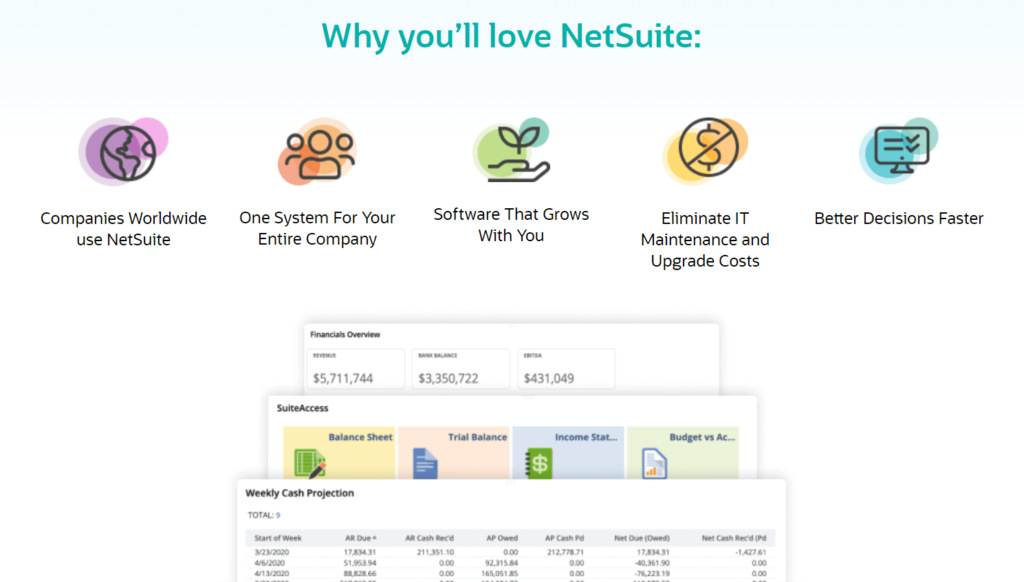
Pricing: Quote Required
Pricing for NetSuite is based on a quote system and varies depending on the company’s size and the business’s specific needs. This cloud-based ERP software is designed for mid-sized businesses and enterprises looking to manage their business operations and financials in one platform.
Best Unified Platform
NetSuite is best for businesses that need a comprehensive ERP system to manage their financials, supply chain, and inventory in one platform. It is suitable for small and mid-sized businesses and large enterprises that operate in multiple countries and require features such as multi-currency support, multi-language support, and tax compliance. NetSuite’s cloud-based solution provides real-time visibility into financial performance. It helps streamline business operations, making it an ideal choice for companies seeking a scalable, customizable, unified platform to manage their operations.
Highlights and Hidden Gems of NetSuite
- End-to-end business management: NetSuite provides a complete, integrated system for managing a wide range of business functions, from financials to inventory and supply chain management, order management, and more.
- Cloud-Based Platform: NetSuite’s cloud-based platform provides users with access to their financial and business data anytime, anywhere. This makes it easy for remote teams to collaborate and for business owners to manage their finances.
- Real-time reporting and analytics: NetSuite’s reporting and analytics capabilities provide businesses with real-time insights into their financial and operational performance, allowing them to make informed decisions and take action based on the latest data.
- Advanced Financial Management: NetSuite’s financial management capabilities offer several advanced features, including automatic bank feeds, transaction categorization, and bank statement reconciliation. This makes it easier for businesses to manage their finances while reducing manual data entry and potential errors.
- Inventory and Order Management: NetSuite offers a robust inventory and order management system that allows businesses to manage their inventory levels, process orders, and track shipments all in one place. This streamlines the e-commerce order fulfillment process, reduces errors and delays, and improves customer satisfaction.
Disadvantages and Limitations of NetSuite
- Customization: While NetSuite is highly customizable, making changes to the system can be time-consuming and expensive. This can be a challenge for businesses with evolving needs.
- Integration: NetSuite can be difficult to integrate with other systems, limiting its usefulness for some businesses.
- Support: While NetSuite offers robust support options, some users have reported that support can be slow to respond to issues or requests for help.
2. Sage Intacct
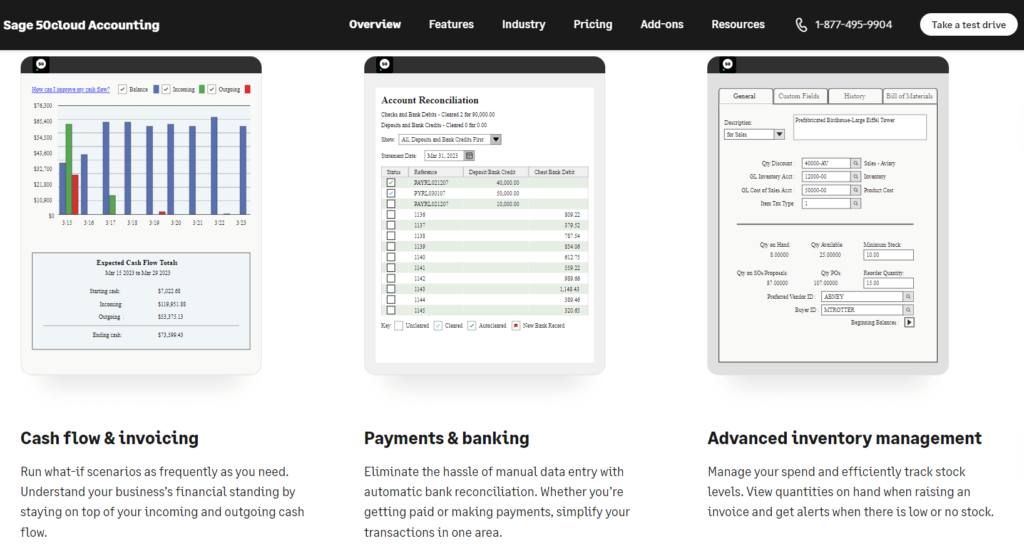
Pricing: Custom Quote Required
The pricing for Sage Intacct is not publicly listed on their website as it is customized for each business based on their specific needs and requirements. Interested businesses can contact Sage Intacct’s sales team for a quote.
Best for Financial Management
Sage Intacct is a cloud-based financial management and accounting software designed for small to mid-sized businesses. It is particularly well-suited for businesses that need advanced financial management capabilities, such as revenue recognition, inventory management, and multi-entity consolidations.
Highlights and Hidden Gems of Sage Intacct
- Customizable dashboards: Sage Intacct allows you to customize dashboards to provide real-time insights into your business performance.
- Easy integration: Sage Intacct seamlessly integrates with other applications, such as Salesforce, ensuring your financial data is always current.
- Multi-entity management: Sage Intacct allows you to easily manage multiple entities, including consolidating financials and intercompany transactions.
- Streamlined financial processes: Sage Intacct streamlines financial processes such as accounts payable, accounts receivable, and cash management, reducing manual work and improving efficiency.
- Comprehensive reporting: Sage Intacct provides comprehensive reporting capabilities, including creating custom reports and dashboards and financial statements such as balance sheets and income statements.
- Automated workflows: Sage Intacct has built-in workflows that automate financial processes, reducing errors and improving efficiency.
- Real-time visibility: With Sage Intacct, you can get real-time visibility into your financial performance, enabling you to make informed business decisions.
- Robust security: Sage Intacct employs multiple layers of security to protect your financial data, including data encryption, firewalls, and intrusion detection systems.
Disadvantages and Limitations of Sage Intacct
- Limited customization: While Sage Intacct offers a high level of functionality, there may be limited customization options for businesses with unique needs.
- Limited add-ons: While Sage Intacct offers a variety of integrations, there may be fewer add-ons and extensions available compared to other ERP systems.
- Integration limitations: Sage Intacct does not integrate with as many third-party applications as some of its competitors.
- Limited mobile app: The Sage Intacct mobile app has limited functionality, which can disadvantage users who rely heavily on mobile access.
3. SAP S/4HANA Cloud

Pricing: Custom Quote
The pricing for SAP S/4HANA Cloud varies depending on the specific needs of the business and the features required. SAP offers a range of pricing options, including monthly subscriptions and pay-as-you-go models. Interested customers can contact SAP for pricing details and a customized quote.
Best Fully Integrated ERP Solution
SAP S/4HANA Cloud is best for medium to large businesses that require a comprehensive and fully integrated ERP solution. The software is particularly suitable for companies in the manufacturing, wholesale distribution, and service industries, as well as those with complex supply chain management needs. With its cloud-based architecture, SAP S/4HANA Cloud is a particularly good fit for businesses with multiple locations or those that require remote access to their ERP system. Additionally, the software is designed to be scalable, allowing businesses to add users and functionality as they grow.
Highlights and Hidden Gems of SAP S/4HANA Cloud
- Comprehensive ERP solution: SAP S/4HANA Cloud offers a full suite of ERP functionalities, including finance, sales, procurement, manufacturing, and project management.
- Intelligent automation: The solution leverages artificial intelligence and machine learning to automate routine tasks and optimize business processes, improving efficiency and reducing errors.
- Real-time analytics: SAP S/4HANA Cloud provides real-time analytics and insights, allowing businesses to make data-driven decisions and quickly adjust to changing market conditions.
- Scalability: As a cloud-based solution, SAP S/4HANA Cloud is highly scalable and can easily adapt to a company’s changing needs as it grows.
- Integration with other SAP tools: SAP S/4HANA Cloud seamlessly integrates with other SAP tools and applications, providing a more comprehensive solution for businesses already using SAP products.
Disadvantages and Limitations of SAP S/4HANA Cloud
- Customization: While SAP S/4HANA Cloud offers a lot of features and capabilities, it can be difficult to customize it to meet specific business needs.
- Learning curve: The system can be challenging to learn, and new users may need a lot of training and support to use it effectively.
- Complexity: The software can be complex and may require specialized training for employees to use effectively.
- Implementation time: The implementation process for SAP S/4HANA Cloud can take several months, which can be a challenge for businesses with tight deadlines.
4. SAP Business One
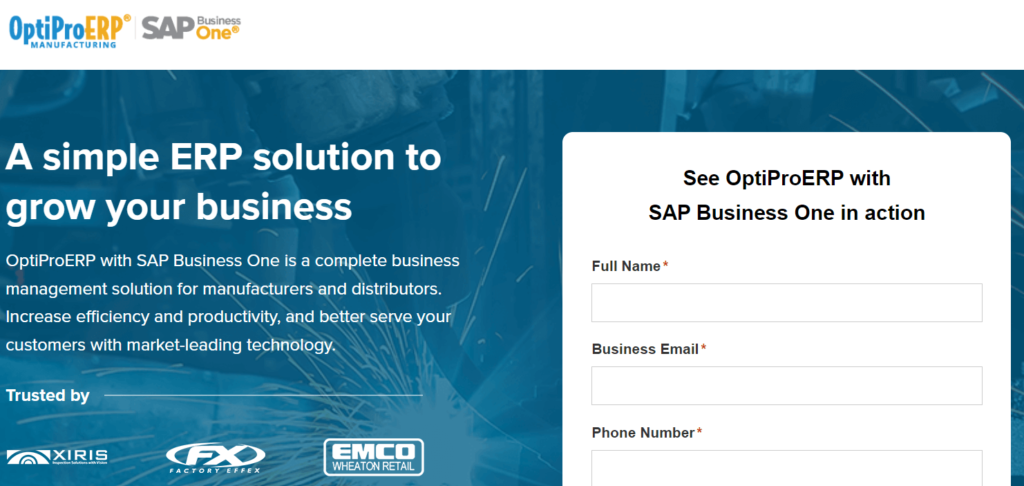
Pricing: Quote Required, Based on Users and Features
The pricing for SAP Business One varies depending on the edition, deployment model, and other factors such as the number of users and the required functionality. Interested users can request a quote directly from SAP or through their network of partners.
Best for Businesses with Complex Operations
SAP Business One is best for small and medium-sized businesses in a variety of industries, including manufacturing, distribution, retail, and services. It is designed to provide a comprehensive solution for managing financials, sales, customer relationships, purchasing, inventory, and operations. It also offers features for project management, production management, and HR management, making it suitable for businesses with complex operations.
Highlights and Hidden Gems of SAP Business One
- Comprehensive financial management: SAP Business One offers a range of financial management tools, including general ledger, accounts payable, accounts receivable, and fixed assets. It also supports multi-currency transactions and has advanced budgeting and forecasting capabilities.
- Robust inventory management: With SAP Business One, businesses can manage inventory levels, track inventory movement, and optimize purchasing and production schedules. The system also includes tools for lot and serial number tracking and batch management.
- Integrated CRM: SAP Business One includes a customer relationship management (CRM) system that allows businesses to track sales leads, manage customer interactions, and create marketing campaigns.
- Streamlined production management: For manufacturers, SAP Business One offers tools for managing bills of materials, production orders, and material requirements planning (MRP). The system can also integrate with shop floor control systems and quality management tools.
- Flexible reporting and analytics: SAP Business One includes various reporting and analytics tools, including built-in dashboards and custom report creation. The system also integrates with popular business intelligence tools like SAP Crystal Reports and SAP Lumira.
Disadvantages and Limitations of SAP Business One
- Complexity: SAP Business One is a complex system that may require a significant amount of training and experience to use effectively.
- Customization: While SAP Business One is highly configurable, making customizations may require programming knowledge, which may not be available to all users.
5. SAP

Pricing: Custom Quote Required
SAP is an enterprise resource planning (ERP) software that offers a range of products and services. The pricing for SAP products and services varies depending on the specific product and deployment options. SAP also offers a range of subscription-based licensing and payment models. Customers can request a quote from SAP directly for pricing information.
Best for Versatility and Scalability
SAP is a highly versatile and customizable ERP software that is best for medium to large-sized businesses across industries such as manufacturing, logistics, finance, retail, and more. SAP provides a comprehensive suite of applications that can help businesses streamline their operations, improve decision-making, and gain insights into their business processes. Its ability to integrate with other systems, such as CRM and SCM systems, also makes it an attractive option for businesses looking to automate their processes and improve efficiency.
Highlights and Hidden Gems of SAP
- End-to-end integration: SAP offers seamless integration across departments, which helps businesses to streamline their operations and reduce errors.
- Real-time data: SAP provides real-time access to business data, enabling users to make informed decisions quickly.
- Advanced analytics: SAP offers advanced analytics capabilities that help businesses gain insights into their operations and make data-driven decisions.
- Industry-specific solutions: SAP offers industry-specific solutions that cater to the unique needs of businesses in different sectors.
- Data Handling: SAP is known for its ability to handle large amounts of data, making it ideal for enterprises with complex data needs.
- Operational Streamlining: The system’s integrated approach to business management means that users can access real-time data across departments, helping to streamline operations and decision-making.
Disadvantages and Limitations of SAP
- Long Implementation Time: Implementing SAP can take a long time, leading to frustration and delays.
- Need for Skilled Professionals: SAP requires skilled professionals to maintain and use the system effectively, which can be costly and difficult to find.
6. Acumatica
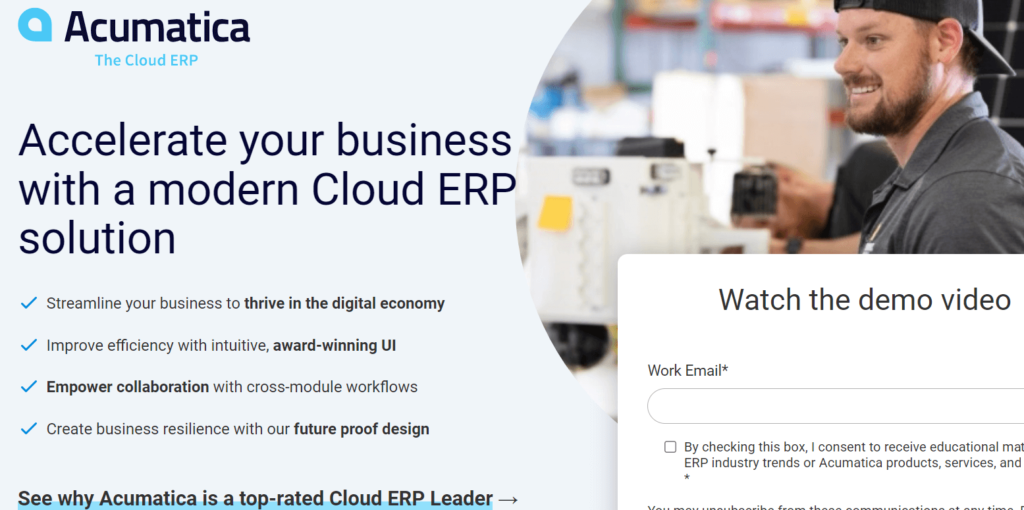
Pricing: Subscription or Perpetual Licensing
Acumatica offers a flexible pricing model that varies depending on the deployment method, licensing model, number of users, and the functional modules required. The company offers both cloud and on-premises deployment options, and users can choose a licensing model that best fits their needs, whether that be a subscription or perpetual license.
Best for ERP Customization
Acumatica is best for small and medium-sized businesses that require an ERP system that can be customized to meet their unique needs. Its flexible and scalable platform allows businesses to add or remove features and functions as their needs change, and it can be used in a variety of industries, such as manufacturing, distribution, retail, and e-commerce. Acumatica is also suitable for businesses with a remote or mobile workforce, as its cloud-based solution allows employees to access the system from anywhere with an internet connection.
Highlights and Hidden Gems of Acumatica
- Flexible Deployment: Acumatica offers a choice of deployment options, including on-premises, private cloud, and public cloud, giving businesses the flexibility to choose the deployment option that suits their needs.
- Advanced Financial Management: The software includes a comprehensive set of financial management features that include general ledger, accounts payable and receivable, fixed assets, cash management, and tax management.
- Streamlined Project Accounting: Acumatica’s project accounting module helps businesses to manage project finances, billing, and profitability and includes features such as budgeting, time and expense tracking, and advanced revenue recognition.
- Advanced Inventory Management: The software includes a comprehensive inventory management module that includes features such as multiple warehouses, lot and serial tracking, automated replenishment, and more.
- Business Intelligence: Acumatica’s business intelligence module includes advanced analytics and reporting capabilities, giving businesses real-time insights into their operations and finances.
- Integrated CRM: Acumatica includes an integrated customer relationship management (CRM) module that helps businesses manage their sales, marketing, and customer service processes.
Disadvantages and Limitations of Acumatica
- Limited reporting capabilities: Acumatica may not have as robust reporting capabilities as other ERP systems.
- Limited Third-Party Integration: While Acumatica has an open API, it may not have as many third-party integrations as other ERP systems.
7. TallyPrime
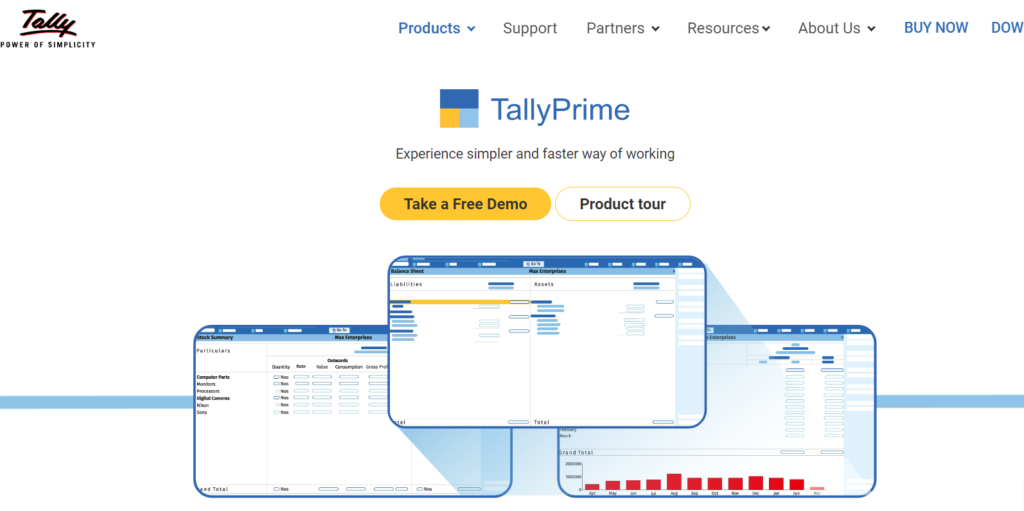
Pricing: Subscription and Perpetual Licensing Options
TallyPrime, a popular accounting and business management software in India, offers both perpetual and subscription-based pricing plans for its users. The perpetual license, which allows users to own the software and access it indefinitely, starts at INR 18,000 (approximately $245) for a single user. In comparison, the subscription-based plans range from INR 3600 (approximately $49) per year for a single user to INR 13,500 (approximately $184) per year for a multi-user license.
Best for SMBs in India
TallyPrime is best for small to medium-sized businesses, particularly those based in India, looking for accounting and ERP software that can manage their financial operations and inventory. The software is suitable for businesses in various industries, including retail, manufacturing, and services. TallyPrime is also suitable for accountants and bookkeepers who manage the financial records of multiple businesses. The software is designed to simplify accounting processes and provide real-time data analysis to help businesses make informed decisions.
Highlights and Hidden Gems of TallyPrime
- Multi-language Support: TallyPrime is available in several languages, including English, Hindi, Bengali, Gujarati, Marathi, and Tamil, making it more accessible to businesses in different regions of India.
- Remote Access: TallyPrime allows users to access their data from anywhere, making it a great option for businesses with multiple locations or remote teams.
- Automation: TallyPrime automates various business processes, including invoicing, inventory management, and financial reporting, which saves time and reduces the risk of errors.
- Data Security: TallyPrime has robust security features that protect business data from unauthorized access, data loss, and cyber threats.
Disadvantages and Limitations of TallyPrime
- Limited customization options: TallyPrime has fewer customization options than some other ERP accounting software, which may limit its ability to fit the specific needs of some businesses.
- Limited integration options: TallyPrime may have limited integration options with third-party applications, which may be a drawback for businesses that rely heavily on specific tools or software.
8. Microsoft Dynamics 365 Business Central
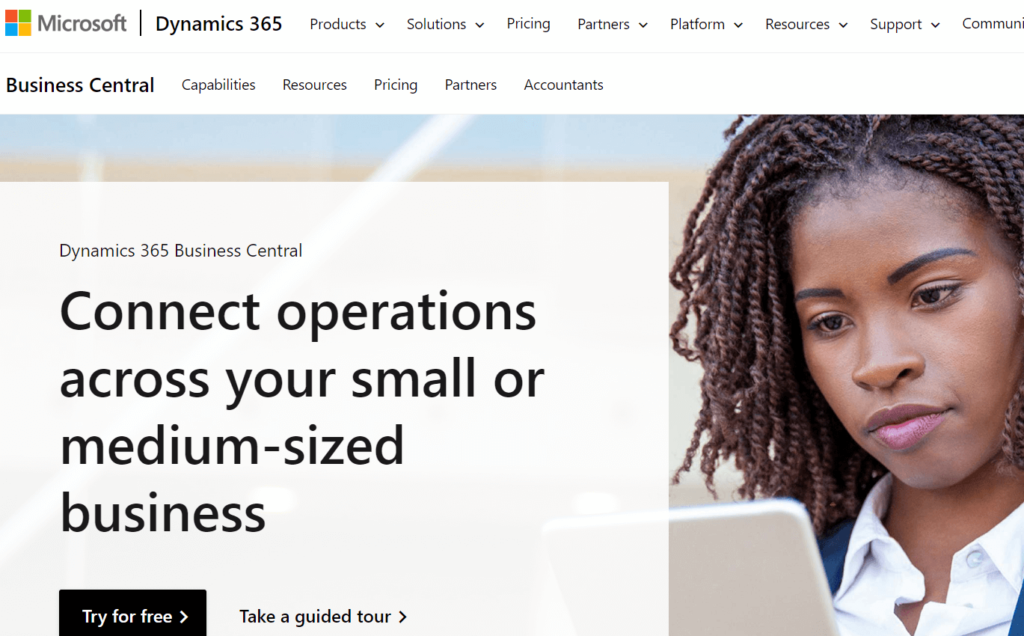
Pricing Starts at $70/user/month
Microsoft Dynamics 365 Business Central pricing varies depending on the specific edition and deployment option chosen. The Essential edition, which includes basic financial management and supply chain features, starts at $70/user/month. In contrast, the Premium edition, which includes additional manufacturing and service management features, starts at $100/user/month. Additional fees may apply for customizations, integrations, and other services. Microsoft offers a free trial and a flexible subscription model, allowing businesses to scale up or down as needed.
Best for Robust Financial Management
Microsoft Dynamics 365 Business Central is a cloud-based ERP system that is designed for small to medium-sized businesses. It is particularly useful for companies that have outgrown their basic accounting software and need a more robust system to manage their finances, operations, and customer relationships. It is also well-suited for businesses that have remote teams or multiple locations, as it allows for centralized management and collaboration.
Highlights and Hidden Gems of Microsoft Dynamics 365 Business Central
- Comprehensive business management solution: Microsoft Dynamics 365 Business Central provides a comprehensive set of tools and features to manage various aspects of a business, including finances, supply chain, sales, inventory, and more.
- Cloud-based platform: As a cloud-based ERP solution, Dynamics 365 Business Central offers the flexibility of any time, anywhere access to critical business data and operations. It allows businesses to easily scale up or down as per their requirements.
- Integration with other Microsoft tools: Dynamics 365 Business Central can be integrated with other Microsoft tools, such as Office 365, Power BI, and Microsoft Teams, to create a seamless and efficient work environment.
- Customizable: The solution is highly customizable, allowing businesses to tailor it to their specific needs and workflows. Customizations can be done with minimal coding, making it easy for businesses to create tailored solutions.
- Artificial Intelligence: Dynamics 365 Business Central leverages artificial intelligence to provide businesses with valuable insights into their operations. The AI capabilities allow for predictive analysis and forecasting to help businesses make informed decisions.
- Security: Microsoft Dynamics 365 Business Central offers robust security features to protect business data from cyber threats and other security risks.
Disadvantages and Limitations of Microsoft Dynamics 365 Business Central
- Cost: As a comprehensive ERP solution, Microsoft Dynamics 365 Business Central can be quite expensive, especially for small businesses on a tight budget.
- Complexity: Business Central is a complex software solution with a lot of functionality, which can be overwhelming for some users who are new to ERP systems.
- Integration challenges: Integrating Business Central with other systems and applications can be a challenge, especially if the organization has legacy systems or custom-built software.